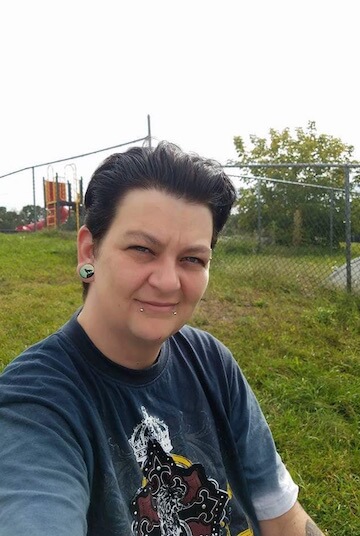Jennifer Goodstein is owner and publisher of Gay City News and its sister publications. | DONNA ACETO
February 2 is National Go Red Day, dedicated to raising awareness about the issue of women and heart disease. As the number one killer of women, heart disease is too often viewed as “an old man’s disease,” causing women to ignore symptoms and fail to seek treatment.
Heart disease became a very personal issue for me this past year. My story is probably similar to that of many women with heart disease, but I hope will serve as a warning for some.
In June 2017, I was diagnosed with hypertrophic cardiomyopathy (HCM), a genetic disease that causes thickening and scarring of the heart muscle. The disease can be controlled through medication, open heart surgery, or a heart transplant. In my case, I needed open heart surgery.
Medical necessity led to open heart surgery; skilled doctors brought me through it
It has been a scary, confusing, challenging year. Looking back on the experience, there is a moment that stands out. As I was being wheeled into the operating room for surgery, I asked my husband, “How did I end up here?”
Over the past four months I have asked that question over and over. The simple answer is: ignorance and denial. Even though HCM is not caused by smoking, poor diet, lack of exercise, old age, or other factors we think of when we consider heart disease, I ignored too many signs pointing to a problem. The problems I did see, I ignored.
I was diagnosed with HCM at age 52. Other than the occasional cold, I was never sick. I exercised regularly, never smoked, had normal blood pressure and good cholesterol, and no chest pain. No reason to think I had heart disease.
February 2 is Go Red Day. | AMERICAN HEART ASSOCIATION
I did have a slight heart murmur my entire life. The murmur never caused a problem and I never thought about it. My cardiologist monitored the murmur by echocardiogram every three years. The regularly scheduled echo is what took me to the cardiologist the day I was diagnosed. I had never heard of HCM and immediately started to research the disease. Big mistake. The online health sites list the first symptom of HCM as sudden death. Time for another tack.
I found a cardiologist who specializes in HCM, Dr. Mark Sherrid at NYU Langone, who has seen thousands of people with the disease.
“HCM is a thickening of the heart walls that occurs for no clinical cause like high blood pressure or heart valve disease. We now know that it’s caused by genetic abnormalities that may not show up until mid-life,” Sherrid told me. “It’s now a highly treatable condition when recognized and treated appropriately. Unfortunately, there’s often a delay in diagnosis, because HCM can masquerade as other conditions, these other conditions include coronary artery disease, mitral valve prolapse, benign flow [heart] murmur, exercised-induced asthma, or panic attacks. The key test is an echocardiogram, which often reveals the true cause of the symptoms.”
Sherrid and his team explained the disease, reviewed the echo and MRI images with me, and said that open heart surgery to remove part of my heart muscle was their recommended treatment. I had a difficult decision to make. Two weeks later, the decision was made for me. I lost consciousness while walking down the street in Manhattan. Surgery was no longer an option, it was a necessity.
On September 13, Dr. Daniel Swistel performed a septal myectomy — he’s one of the few surgeons in the world who has performed hundreds of such operations in his career — and mitral valve repair, and five days later a defibrillator/ pacemaker was implanted in my chest at NYU Langone.
Drs. Sherrid and Swistel have worked together for more than 20 years, doing research and publishing much of the leading work on HCM. They run the NYU-Langone’s HCM Center of Excellence — a high-volume, high-success, research-oriented unit staffed by a team of talented, caring doctors, nurses, and technicians who know how to diagnose and treat HCM. Thanks to them, my surgery was successful and I feel better than I have in years.
Looking back, I realize how the disease slowly took over my life. And I let it.
I spent more than a year with symptoms and never addressed them. I had fatigue, shortness of breath and dizziness when standing up. As I became fatigued more and more often I blamed age and stress. The shortness of breath was blamed on not spending enough time in the gym. I wrote off the dizziness to an inner ear problem or anemia or lack of sleep. The problems were vague and intermittent, and I did not consider them important enough to interrupt my family and work responsibilities. Like many women, I was more focused on the people around me than my own health.
I still have HCM even though the surgery relieved my symptoms. I will need echocardiograms and medication for the rest of my life to monitor and control my heart disease. Thanks to the Hypertrophic Cardiomyopathy Association, a non-profit that helps people with HCM, I have found a support group that understands what it’s like to live with HCM.
Most importantly, I have a new awareness and respect for my health. I have a better understanding of what the symptoms of heart disease are for women and can be more diligent about getting help before a serious situation arises. That is my hope for you, that you have knowledge and have awareness of your heart health.
Take care of yourself; it’s the best gift you can give to those you love.
Jennifer Goodstein is the publisher and owner of Gay City News, NYC Community Media, and the Community News Group.




































